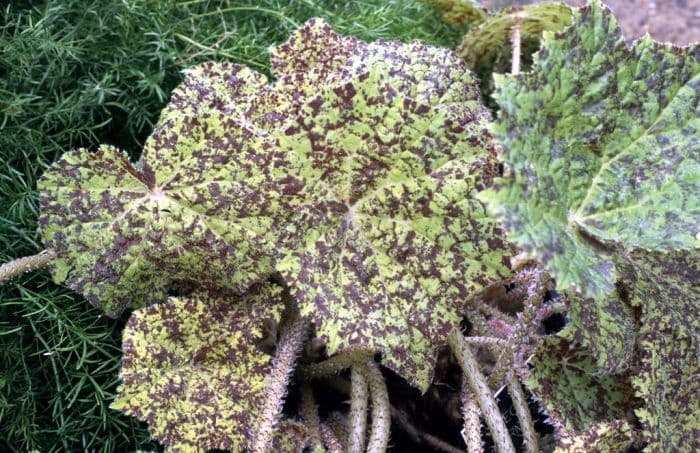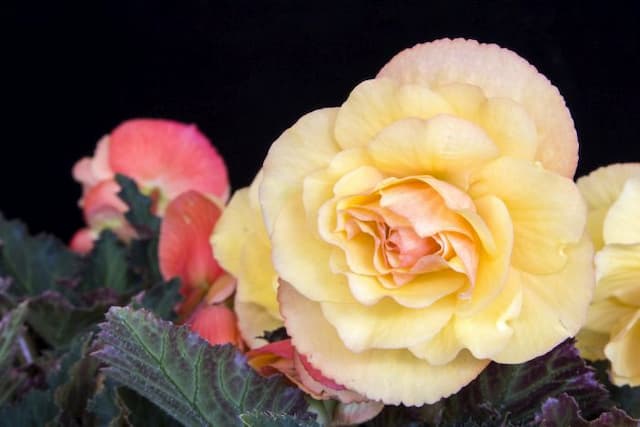Marmaduke Begonia Begonia 'Marmaduke'

ABOUT
The Begonia 'Marmaduke' is prominent for its lush, vibrant foliage and bright, showy flowers, which grace it with a striking appearance. Featuring broad leaves, this variety boasts a rich, almost metallic texture, with a color palette that includes deep greens, reds, and even purplish hues, often with a shimmery or iridescent finish. These leaves are typically heart-shaped, sometimes with a serrated or wavy edge, adding to the plant's dramatic visual impact. The flowers of the 'Marmaduke' are equally captivating, standing out with their radiant colors that can range from soft pinks and whites to vivid oranges and reds. These blossoms are usually arranged in clusters, providing a delightful contrast against the darker tones of the foliage. Structurally, each flower is delicate and may have either a waxy or velvety texture, which attracts observers and pollinators alike. Overall, the Begonia 'Marmaduke' is a striking ornamental plant that has a lush, full appearance and is renowned for its richly colored leaves and charming flowers, making it a beloved choice for gardeners and plant enthusiasts who aim to add a splash of color and texture to their indoor or outdoor spaces.
About this plant
 Names
NamesSynonyms
Marmaduke Begonia.
Common names
Begonia 'Marmaduke'.
 Toxicity
ToxicityTo humans
Begonias, including the 'Marmaduke' variety, can be toxic if ingested. They contain compounds that can cause irritation to the mouth, throat, and gastrointestinal tract if eaten. Symptoms of begonia poisoning in humans may include a burning sensation in the mouth, difficulty swallowing, nausea, vomiting, and diarrhea. In most cases, the toxicity is mild, but it is advisable to consult a healthcare professional if ingestion occurs, especially in children and individuals with sensitivities.
To pets
Begonias, including the 'Marmaduke' variety, are also toxic to pets. The ingestion of begonias can cause oral irritation, excessive drooling, vomiting, and difficulty swallowing in pets like cats and dogs due to the irritating compounds in the plant. If a pet consumes part of a begonia, it is important to contact a veterinarian, as treatment may be needed to manage the symptoms and ensure the pet's safety.
 Characteristics
CharacteristicsLife cycle
Perennials
Foliage type
Evergreen
Color of leaves
Mixed
Flower color
Varies
Height
1-2 feet (30-60 cm)
Spread
1-2 feet (30-60 cm)
Plant type
Herb
Hardiness zones
10
Native area
Tropical Asia
Benefits
 General Benefits
General Benefits- Ornamental Appeal: Begonia 'Marmaduke' has striking foliage and bright flowers that add aesthetic value to gardens and indoor spaces.
- Low Maintenance: This plant typically requires minimal care, making it suitable for busy gardeners or those new to plant care.
- Versatility: Able to thrive in a variety of settings, from hanging baskets to containers, making it a flexible choice for different gardening projects.
- Drought Tolerance: Once established, Begonia 'Marmaduke' can tolerate periods of drought, needing less frequent watering than many other plants.
- Shade Tolerance: Performs well in shady areas where other plants might struggle, providing color and life to less sunny spots.
- Long Blooming: This plant often has an extended blooming period that lasts for several months, offering long-lasting beauty.
- Non-Toxicity: Safe for homes with pets or children, as it is not known to be toxic if ingested.
 Medical Properties
Medical PropertiesThis plant is not used for medical purposes.
 Air-purifying Qualities
Air-purifying QualitiesThis plant is not specifically known for air purifying qualities.
 Other Uses
Other Uses- Photo Shoots: Begonia 'Marmaduke' can be an attractive backdrop or feature in garden photography due to its unique foliage and coloration.
- Educational Tool: Horticulture students can study the plant as an example of hybridization and Begonia care.
- Aquarium Landscaping: The colorful leaves can be used in terrariums or paludariums, but not submerged.
- Feng Shui: Some believe that placing a Begonia in specific areas of the home can bring positive energy and improve Feng Shui.
- Artistic Inspiration: Artists can use the intricate patterns and vibrant colors of the leaves as inspiration for paintings, drawings, or textile designs.
- Collectibles: Enthusiasts might grow Begonia 'Marmaduke' as part of a Begonia collection due to its distinctive appearance.
- Crafting: Dried leaves of Begonia 'Marmaduke' can be used in scrapbooking or other paper crafts for decoration.
- Table Decor: Fresh leaves can be arranged on dinner tables for unique, nature-themed place settings or centerpieces.
- Plant Swap: Gardeners may propagate this plant for trading at plant swap events, fostering community and sharing among garden enthusiasts.
- Costume Design: Elements of the Begonia 'Marmaduke', such as its leaves, can inspire or be incorporated into costumes for theater productions or cosplay.
Interesting Facts
 Feng Shui
Feng ShuiThe Begonia is not used in Feng Shui practice.
 Zodiac Sign Compitability
Zodiac Sign CompitabilityThe Begonia is not used in astrology practice.
 Plant Symbolism
Plant Symbolism- Caution: Begonias are often associated with warnings or heedfulness. The 'Marmaduke' variety, like its counterparts, may symbolize the need for caution in new situations.
- Unity: They can also symbolize unity. The clustering flowers of the Begonia 'Marmaduke' suggest groups coming together in harmony.
- Individuality: Begonias often highlight individuality, with their unique patterns and foliage, encouraging one to stand out and be distinctive.
- Friendship: Given as gifts, begonias can represent friendship and deep appreciation for the bonds between people.
- Peace and Harmony: The soothing look of Begonia 'Marmaduke' provides a sense of calm, which is why it may symbolize peace and a balanced life.
 Water
WaterFor the Rex Begonia, water thoroughly but infrequently, allowing the top inch of soil to dry out between waterings. Typically, watering every 7-10 days is sufficient, but this can vary based on environmental conditions such as temperature and humidity. When watering, use approximately 16 ounces of water for a small pot of about 6 inches, adjusting the amount proportionally for larger pots. It is important to avoid waterlogged soil, so make sure the pot provides proper drainage.
 Light
LightRex Begonias thrive in bright, indirect light but can tolerate lower light conditions. They should not be placed in direct sunlight, which can scorch their leaves. An ideal spot would be near a north or east-facing window that receives plenty of natural light without direct sun exposure throughout the day.
 Temperature
TemperatureRex Begonias prefer consistently warm conditions, ideally between 60 and 75 degrees Fahrenheit. They should not be exposed to temperatures below 50 degrees Fahrenheit, as cold drafts and sudden temperature changes can harm the plant. Maintaining a stable temperature within the preferred range will promote healthy growth.
 Pruning
PruningPruning Rex Begonias is important for encouraging bushier growth and removing any dead or yellowing leaves. It’s best to prune in the spring or after flowering. You can pinch back the new growth every few weeks during the growing season to promote a fuller plant. Avoid heavy pruning, as this can stress the plant.
 Cleaning
CleaningAs needed
 Soil
SoilBegonias prefer a well-draining soil mix consisting of peat, perlite, and compost in equal parts. The ideal pH for Begonia 'Marmaduke' should be slightly acidic, around 5.5 to 6.5, to ensure optimal growth and health.
 Repotting
RepottingBegonia 'Marmaduke' should be repotted every 1-2 years or when it becomes root-bound. Repotting in spring is best, allowing the plant to recover and grow into the new growing season.
 Humidity & Misting
Humidity & MistingBegonia 'Marmaduke' thrives in high humidity conditions, ideally between 50% to 70%. Avoid placing it in dry environments as this can adversely affect its health and growth.
 Suitable locations
Suitable locationsIndoor
Place in bright, indirect light; keep soil moist but not soggy.
Outdoor
Place in partial shade; protect from strong winds and intense midday sun.
Hardiness zone
10-11 USDA
 Life cycle
Life cycleThe life cycle of the Begonia 'Marmaduke', commonly known as the Marmaduke Begonia, begins with seed germination, which takes place in warm, moist soil conditions. After sprouting, the seedling emerges and develops into a juvenile plant, featuring characteristic heart-shaped leaves and a bushy growth habit. As it matures, the Marmaduke Begonia enters the vegetative stage, during which it experiences rapid growth of foliage and roots and prepares for the flowering stage. During the flowering stage, the plant produces clusters of colorful blossoms, which can be white, pink, or red, depending on the variety, and this stage can recur seasonally. After pollination, seeds develop and are eventually dispersed, either through natural means or human intervention, to begin the cycle anew. Finally, under suitable conditions, the Marmaduke Begonia may also propagate vegetatively through leaf cuttings or division, thereby bypassing seed production and creating a genetic clone of the parent plant.
 Propogation
PropogationPropogation time
Spring-Early Summer
The Begonia 'Marmaduke,' renowned for its stunning foliage, is commonly propagated through leaf cuttings. This method involves taking a healthy, mature leaf from the plant, cutting it into sections with each section having at least one vein. Each section is then placed on moist potting mix or a similar medium. The leaf sections should be laid flat on the surface, and you can optionally weigh them down gently with a pebble or similar small weight to ensure contact with the soil. Keep the soil consistently moist but not waterlogged and in a warm location with indirect light. Rooting typically occurs within a few weeks, after which new growth will become apparent, signaling that it's time to pot the new Begonia plants into individual containers.
![Begonia [Amour]](/_next/image?url=https%3A%2F%2Fplants-admin.emdemapps.com%2Fimages%2Fplants%2F%2Fimages%2F604b6461837a3.png&w=640&q=75)

![Begonia [Bonfire]](/_next/image?url=https%3A%2F%2Fplants-admin.emdemapps.com%2Fimages%2Fplants%2F%2Fimages%2F604b6124363f0.png&w=640&q=75)


![Begonia [Cherry Bon Bon]](/_next/image?url=https%3A%2F%2Fplants-admin.emdemapps.com%2Fimages%2Fplants%2F%2Fimages%2F604b63cca3ce5.png&w=640&q=75)

![Begonia [Dainty Dancer]](/_next/image?url=https%3A%2F%2Fplants-admin.emdemapps.com%2Fimages%2Fplants%2F%2Fimages%2F604b644f5522c.png&w=640&q=75)

![Begonia [Elegance]](/_next/image?url=https%3A%2F%2Fplants-admin.emdemapps.com%2Fimages%2Fplants%2F%2Fimages%2F604b5cae46f7b.png&w=640&q=75)